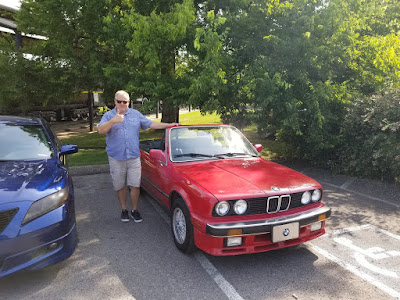Datsun sent power to the headlights in a way that was not common to US autos: a single 12v+ switched wire is sent to the common terminal while two grounds are wired between the Hi/Lo switch on the column and the remaining two terminals on the bulbs. For a normal incandescent bulb this would not matter, but for an LED bulb the direction of the current matters and Datsun's reversed setup would require some changes. While headlight relays are common for 240z's, I couldn't find one for a 280z so I decided to make my own. I picked up some 14 gauge wire and a set of fused relays for this purpose: ONLINE LED STORE 6 Pack 30A Fuse Relay Switch Harness Set
After removing the existing headlights, buckets, and wiring harnesses, I created a new harness that would control the relays. This was done by connecting the 12v+ to the coils on both relays, then connecting each of the switched grounds to a separate relay. I used Delco Weatherpack connectors for one side of my harness and the existing connector to attach to the current headlight wiring. I replaced the crumbling sheathing with new heat shrink tubing to protect the wires.
Since I only needed one harness to feed the relays, I capped the driver side headlight connection with an old plastic cap.
Next I started working on the relay harness. I decided that I would ground the headlights on the chassis near the radiator, and that I would pick up the main 12v from the starter lug. There was some trial and error involved in figuring out the wiring, but I eventually landed on the red/white wire for the trigger coil on the low beams and the red/black wire for the hi beams. From the relays, the switched side of each is run to two weatherpack connectors, one for each headlight. Each wire is split at the right length, which is the center support for the lower grill. Again, long heat shrink tubes were used to protect the wires.
Connections from the relay harness to each headlight were made in a similar manner and run through the headlight buckets. New grommets were used to protect the wires.
These particular headlights were such a tight fit into the buckets that I had to shave one of the positioning tabs in order to allow the headlight to sit properly into the bucket.
The relays were mounted behind the fusible links using exiting weld nuts and stainless hardware.
The wires were run to the front radiator area on top of the existing wiring running to the same location.
After clearing some bare metal from the front lower grill brace, the ground for the headlights was secured and covered with silicone paste to protect from corrosion.
The headlight assemblies were then returned to their home and the new wiring routed to the corresponding weatherpack connectors. The headlights protrude from the buckets just a but more than the original units, but it's not enough to be noticeable unless you're looking for it.
Testing of the lights was successful and I can now call my LED conversion complete! The new headlights are much whiter and brighter than the previous halogen units.



















































